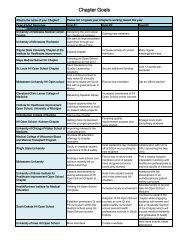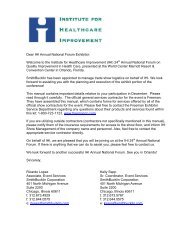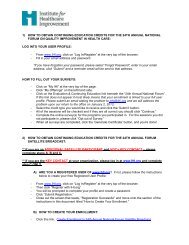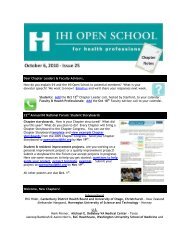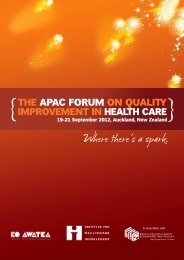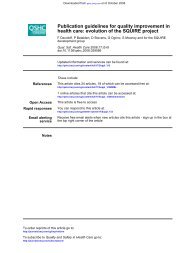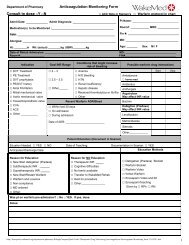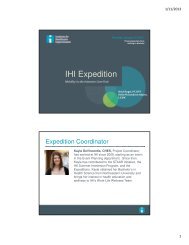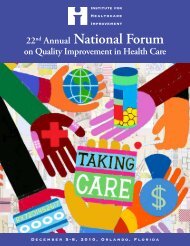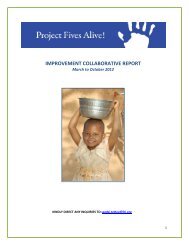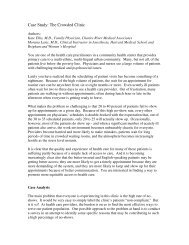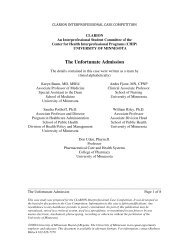moments - Institute for Healthcare Improvement
moments - Institute for Healthcare Improvement
moments - Institute for Healthcare Improvement
You also want an ePaper? Increase the reach of your titles
YUMPU automatically turns print PDFs into web optimized ePapers that Google loves.
PRE-CONFERENCE<br />
monday<br />
DECEMBER 10<br />
M17: Strategies <strong>for</strong> Facilitating Change in<br />
Primary Care<br />
Crystal Ballroom Salon K-M<br />
Primary care practices face daunting challenges <strong>for</strong><br />
trans<strong>for</strong>mation. Regardless of the technical nature<br />
of the challenge (e.g., converting to electronic<br />
medical records or the patient-centered medical<br />
home), effective facilitation of change depends on<br />
diagnosis of gaps. This Minicourse will present<br />
methods and tools <strong>for</strong> making such diagnoses, as<br />
well as effective intervention strategies that can<br />
be used by facilitators whether or not they have<br />
<strong>for</strong>mal authority.<br />
After this session, participants will be able to:<br />
• Explain how to map a change project to<br />
diagnose the effectiveness of current change<br />
management roles and alignment<br />
• Identify strategies <strong>for</strong> responding to gaps in<br />
roles and alignment, including advocacy<br />
• Identify strategies <strong>for</strong> skillful response to<br />
reactivity and resistance<br />
Baker, N., MD, Principal, Neil Baker Coaching and<br />
Consulting, LLC; Lefebvre, A., MSW, Associate Director,<br />
UNC–Chapel Hill; Sevin, C., RN, Director, IHI<br />
M18: ThedaCare’s Business Per<strong>for</strong>mance<br />
System M<br />
Grand Ballroom Salon 4<br />
Organizations that focus on Lean improvement<br />
strategies face a critical question: How is<br />
trans<strong>for</strong>mational work sustained <strong>for</strong> the long<br />
term? ThedaCare’s lean journey, which started<br />
more than eight years ago, offers some answers to<br />
this question. Its lean management system, the<br />
Business Per<strong>for</strong>mance System, is designed to help<br />
managers understand their per<strong>for</strong>mance and meet<br />
their targets while developing people and building<br />
effective teams. This presentation will focus on<br />
identifying the point in the lean journey when<br />
a systematic management system is needed to<br />
sustain value stream results and create momentum<br />
around daily continuous improvement.<br />
After this session, participants will be able to:<br />
• Experiment with the core components of<br />
a management system like the Business<br />
Per<strong>for</strong>mance System<br />
• Explain the standard work and cascades of<br />
in<strong>for</strong>mation required to create and sustain a<br />
system of continuous improvement<br />
• Experiment with the integration of lean tools<br />
such as A3 thinking with leadership standards<br />
work to move an organization beyond value<br />
streams<br />
Barnas, K., Senior Vice President, ThedaCare;<br />
Schaffmeyer, M., COO, Care Transitions and<br />
Homecare Division, ThedaCare<br />
get results<br />
M19: Better Quality Through Better<br />
Measurement<br />
Crystal Ballroom Salon D<br />
Good decision-making is based on systematically<br />
collected and analyzed data. This session will<br />
provide participants with a framework and<br />
practical recommendations <strong>for</strong> avoiding<br />
roadblocks in their quality measurement journeys.<br />
Linking measurement to improvement strategies<br />
will be discussed, and case studies and exercises<br />
demonstrating the application of measurement<br />
principles to health care topics will also be<br />
presented.<br />
After this session, participants will be able to:<br />
• Distinguish between data <strong>for</strong> research,<br />
judgment, and improvement<br />
• Decide which control chart is most appropriate<br />
<strong>for</strong> their data<br />
• Link measurement ef<strong>for</strong>ts to improvement<br />
strategies<br />
Lloyd, R., PhD, Executive Director, Per<strong>for</strong>mance<br />
<strong>Improvement</strong>, IHI; Scoville, R., PhD, <strong>Improvement</strong><br />
Advisor and Consultant, IHI; Little, K., PhD, Principal,<br />
In<strong>for</strong>ming Ecological Design, LLC<br />
M20: Beyond Basics: Using Advanced<br />
SPC Charts M<br />
Harbor Beach<br />
What should we do when the limits on our<br />
control charts are so narrow that all of the data<br />
fall outside them? What about seasonal factors<br />
or rare events? In this session, we explore more<br />
advanced uses <strong>for</strong> statistical process control (SPC)<br />
charts <strong>for</strong> health care. Presenters will address T<br />
and G charts <strong>for</strong> rare events data, Prime charts,<br />
adjustments <strong>for</strong> autocorrelation and <strong>for</strong> seasonality,<br />
the use of the CUSUM control charts, and more.<br />
We recommend that participants bring laptops to<br />
this Minicourse to use in data analysis.<br />
After this session, participants will be able to:<br />
• Select the appropriate SPC chart <strong>for</strong> rare<br />
events data<br />
• Identify when it is most appropriate to use a<br />
CUSUM control chart<br />
• Create a variety of advanced SPC charts using<br />
the Excel templates provided<br />
Murray, S., <strong>Improvement</strong> Advisor, CT Concepts;<br />
Provost, L., Statistician and Senior <strong>Improvement</strong><br />
Advisor, Associates in Process <strong>Improvement</strong><br />
M21: Designing and Executing Large-Scale<br />
Interventions <strong>for</strong> Improving Perinatal and<br />
Infant Outcomes<br />
Key West<br />
What are the underlying drivers of maternal<br />
and infant mortality and morbidity, and what<br />
interventions are most likely to succeed in driving<br />
down the high rates that currently prevail in the<br />
United States? The improvement community has<br />
been working on this issue <strong>for</strong> many years in the<br />
US and other high-income countries, as well as<br />
in low- and middle-income countries, and what<br />
it has learned can be used to design and execute<br />
successful large-scale interventions <strong>for</strong> improving<br />
perinatal and infant outcomes. In this Minicourse,<br />
participants will be provided with high-level input<br />
from national and global experts combined with<br />
creative opportunities <strong>for</strong> planning and executing<br />
large-scale interventions to reduce perinatal<br />
mortality. Although NICU care is a crucial part of<br />
this problem, the Minicourse will focus on non-<br />
NICU solutions to perinatal morbidity<br />
and mortality.<br />
After this session, attendees will be able to:<br />
• Explain the differing epidemiology and causes<br />
of perinatal mortality and mortality in the<br />
United States and other parts of the world<br />
• Describe the use of driver diagrams to explore<br />
causes, measures, and ideas <strong>for</strong> improving<br />
perinatal care<br />
• Demonstrate familiarity with the different<br />
levels of the system (community, patient,<br />
providers, health facilities, states, nations) that<br />
can be targeted to improve outcomes, as well as<br />
possible designs (collaboratives, campaigns,<br />
policy change, leadership intervention) <strong>for</strong><br />
effective large-scale interventions<br />
Barker, P., MD, MB ChB, Senior Vice President, IHI;<br />
Bisognano, M., President and CEO, IHI; Gullo, S.,<br />
RN, Managing Director, IHI; Homer, C., MD, CEO,<br />
National Initiative <strong>for</strong> Children’s <strong>Healthcare</strong> Quality<br />
(NICHQ)<br />
M22: Zero Events of Harm: Leading <strong>for</strong><br />
High Reliability C<br />
Grand Ballroom Salon 3<br />
To achieve and sustain significant improvement<br />
in patient safety (e.g., zero events of harm), health<br />
care can employ strategies from other industries<br />
that have proven to be highly reliable and safe.<br />
Reliability experts and executives from organizations<br />
where these strategies have been used will share<br />
their experiences and the lessons they have learned<br />
in implementing reliability principles. Lessons<br />
from the science of safety, implementation of a<br />
defined leadership method, and approaches <strong>for</strong><br />
a more robust culture of safety will also be<br />
discussed in this Minicourse.<br />
16<br />
24th Annual National Forum on Quality <strong>Improvement</strong> in Health Care



